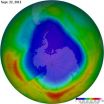(Press-News.org) Scientists may have discovered why the standard treatment for Parkinson's disease is often effective for only a limited period of time. Their research could lead to a better understanding of many brain disorders, from drug addiction to depression, that share certain signaling molecules involved in modulating brain activity.
A team led by Bernardo Sabatini, Takeda Professor of Neurobiology at Harvard Medical School, used mouse models to study dopamine neurons in the striatum, a region of the brain involved in both movement and learning. In people, these neurons release dopamine, a neurotransmitter that allows us to walk, speak and even type on a keyboard. When those cells die, as they do in Parkinson's patients, so does the ability to easily initiate movement. Current Parkinson's drugs are precursors of dopamine that are then converted into dopamine by cells in the brain.
The flip side of dopamine dearth is dopamine hyperactivity. Heroin, cocaine and amphetamines rev up or mimic dopamine neurons, ultimately reinforcing the learned reward of drug-taking. Other conditions such as obsessive-compulsive disorder, Tourette syndrome and even schizophrenia may also be related to the misregulation of dopamine.
In the October 11 issue of Nature, Sabatini and co-authors Nicolas Tritsch and Jun Ding reported that midbrain dopamine neurons release not only dopamine but also another neurotransmitter called GABA, which lowers neuronal activity. The previously unsuspected presence of GABA could explain why restoring only dopamine could cause initial improvements in Parkinson's patients to eventually wane. And if GABA is made by the same cells that produce other neurotransmitters, such as depression-linked serotonin, similar single-focus treatments could be less successful for the same reason.
"If what we found in the mouse applies to the human, then dopamine's only half the story," said Sabatini.
The surprising GABA story began in the Sabatini lab with a series of experiments designed to see what happens when cells release dopamine. The scientists used optogenetics, a powerful technique that relies on genetic manipulation to selectively sensitize cells to light. In laboratory dishes, researchers tested brain tissue from mice engineered to show activity in dopamine neurons. Typically in such experiments, other neurotransmitters would be blocked in order to highlight dopamine, but Tritsch, a postdoctoral fellow in the Sabatini lab, decided instead to keep the cell in as natural a state as possible.
When Tritsch activated the dopamine neurons and examined their effects on striatal neurons, he naturally expected to observe the effects of dopamine release. Instead, he saw rapid inhibition of the striatal neurons, making it clear that another neurotransmitter – which turned out to be the quick-acting GABA – was at work. This was so unusual that the team launched a series of experiments to confirm that GABA was being released directly by these dopamine neurons.
A standard way to detect GABA is to look for vesicular GABA transporter, or VGAT, a protein that packages and carries GABA into neurotransmitter vesicles. The scientists silenced the gene that makes VGAT in mice and found that the dopamine neurons released GABA even in the absence of VGAT.
The researchers then tested other transporters, zeroing in on one that ferries dopamine and a variety of other neurotransmitters. For reasons they don't yet understand, this protein – the vesicular monoamine transporter – also shuttles GABA.
"What makes this important now is that every manipulation that has targeted dopamine by targeting the vesicular monoamine transporter has altered GABA as well. And nobody's paid any attention to it," said Sabatini. "Every Parkinsonian model that we have in which we've lost dopamine has actually lost GABA, too. So we really have to go back now and think: Which of these effects are due to loss of GABA and which are due to loss of dopamine?"
Anatol Kreitzer, an assistant investigator at the Gladstone Institute of Neurological Disease in San Francisco, who was not involved in the research, called the findings remarkable.
"It was totally unexpected," said Kreitzer, who is also an assistant professor of physiology and neurology at the University of California, San Francisco. "At the molecular level, nobody really expected dopamine neurons to be releasing significant amounts of GABA. At the functional level, it's surprising that this major modulator of plasticity in the brain, which is so critical for Parkinson's, for learning and rewards, and for other psychiatric illnesses, can also release GABA. That raises a question as to what role GABA has."
GABA can very quickly change the electrical state of cells, inhibiting their activity by making them less excitable. Sabatini wonders if the loss of GABA in dopamine neurons could explain why hyperactivity is sometimes seen after chronic loss of these neurons.
The next challenge will be to explore whether other neurons that express the vesicular monoamine transporter also release GABA in addition to neurotransmitters such as serotonin and noradrenaline.
"These findings highlight how little we actually know about the most basic features of cell identity in the brain," said Sabatini.
Tritsch said what started out as a straightforward project to understand dopamine quickly changed direction, with lots of starts and stops on the way to some exciting new findings.
"It can be nice to come up with a hypothesis, test it, verify it, and have everything fall into place," he said. "But biology rarely works that way."
###
This research was funded by a Nancy Lurie Marks Family Foundation postdoctoral fellowship and by grants from the National Institutes of Health (NS046579 and 4R00NS075136).
Challenging Parkinson's dogma
2012-10-25
ELSE PRESS RELEASES FROM THIS DATE:
Self-affirmation enhances performance, makes us receptive to our mistakes
2012-10-25
Life is about failure as much as it is about success. From the mistakes we make at work or school to our blunders in romantic relationships, we are constantly reminded of how we could be better. By focusing on the important qualities that make us who we are – a process called self-affirmation – we preserve our self-worth in the face of our shortcomings.
Self-affirmation has been shown to have powerful effects – research suggests that it can minimize the anxiety, stress, and defensiveness associated with threats to our sense of self while keeping us open to the idea that ...
NASA sees tiny Tropical Storm Tony traveling
2012-10-25
Satellite imagery indicated that Tropical Storm Tony is a small, compact storm, traveling through the central Atlantic Ocean.
On Oct 23, Tropical Depression 19 strengthened into Tropical Storm Tony in the central Atlantic Ocean. NOAA's GOES-13 satellite captured an image of Tony on Oct. 24 at 7:45 a.m. EDT that revealed that Tony is relatively small as it moves through the central Atlantic. Tropical storm force winds extend outward up to 70 miles (110 km) from the center. Tony is just over 140 miles in diameter as seen on the GOES-13 image. The GOES-13 satellite image ...
Living power cables discovered
2012-10-25
A multinational research team has discovered filamentous bacteria that function as living power cables in order to transmit electrons thousands of cell lengths away.
The Desulfobulbus bacterial cells, which are only a few thousandths of a millimeter long each, are so tiny that they are invisible to the naked eye. And yet, under the right circumstances, they form a multicellular filament that can transmit electrons across a distance as large as 1 centimeter as part of the filament's respiration and ingestion processes.
The discovery by scientists at Aarhus University ...
Americans use more efficient and renewable energy technologies
2012-10-25
Americans used less energy in 2011 than in the previous year due mainly to a shift to higher-efficiency energy technologies in the transportation and residential sectors. Meanwhile, less coal was used but more natural gas was consumed according to the most recent energy flow charts released by Lawrence Livermore National Laboratory.
Wind power saw the biggest jump from .92 quadrillion BTU, or quads, in 2010 up to 1.17 quads in 2011. (BTU or British Thermal Unit is a unit of measurement for energy and is equivalent to about 1.055 kilojoules).
"Wind energy jumped significantly ...
U of A medical researchers use simple intervention to improve osteoporosis treatment rates
2012-10-25
Older patients who visited local ERs for chest pain or breathing problems and had chest x-rays reveal unknown spinal fractures, were more apt to receive osteoporosis treatment afterward if a simple intervention was used, recently published medical research from the University of Alberta has found.
Treatment rates for the bone-thinning condition substantially improved when patients and their family doctors received follow-up information about the warning signs and risk factors. It is the first and only trial in the world that looked at spinal osteoporosis.
Of those ...
Pigs look healthy but test positive for flu at fairs; transmission seen between pigs and humans
2012-10-25
COLUMBUS, Ohio – More than 80 percent of pigs that tested positive for influenza A virus at Ohio county fairs between 2009 and 2011 showed no signs of illness, according to a new study.
Ohio State University researchers tested 20 pigs each at 53 fair events over those three summers and found at least one flu-positive pig at 12 fairs – almost a quarter of fairs tested.
The influenza strains identified in pigs in this study include H1N2 and H3N2 viruses – strains that have been circulating in pigs since 1998. In 2011, all of the H3N2 and H1N2 isolates found in pigs ...
Which candidate will be best for the stock market...?
2012-10-25
DeKALB, Ill. -- With Election Day less than a month away, television is filled with talking heads spreading the conventional wisdom of what a Republican or Democratic president might mean for the economy.
However, a group of researchers says, when it comes to the relationship between presidential politics and the behavior of the financial markets, conventional wisdom may not be so wise.
The researchers reviewed more than 40 years of data (1965-2008) in studying the relationship between security returns and four variables: the political affiliation of the president; ...
CU-Boulder researchers uncover new target for cancer research
2012-10-25
In a new paper released today in Nature, BioFrontiers Institute scientists at the University of Colorado Boulder, Tom Cech and Leslie Leinwand, detailed a new target for anti-cancer drug development that is sitting at the ends of our DNA.
Researchers in the two scientists' laboratories collaborated to find a patch of amino acids that, if blocked by a drug docked onto the chromosome end at this location, may prevent cancerous cells from reproducing. The amino acids at this site are called the "TEL patch" and once modified, the end of the chromosome is unable to recruit ...
2012 Antarctic ozone hole second smallest in 20 years
2012-10-25
WASHINGTON -- The average area covered by the Antarctic ozone hole
this year was the second smallest in the last 20 years, according to
data from NASA and National Oceanic and Atmospheric Administration
(NOAA) satellites. Scientists attribute the change to warmer
temperatures in the Antarctic lower stratosphere.
The ozone hole reached its maximum size Sept. 22, covering 8.2 million
square miles (21.2 million square kilometers), or the area of the
United States, Canada and Mexico combined. The average size of the
2012 ozone hole was 6.9 million square miles (17.9 ...
Plants provide accurate low-cost alternative for diagnosis of West Nile Virus
2012-10-25
While the United States has largely been spared the scourge of mosquito-borne diseases endemic to the developing world—including yellow fever, malaria and dengue fever—mosquito-related illnesses in the US are on the rise. One pathogen of increasing concern in the U.S. is an arbovirus known as West Nile.
Now Qiang "Shawn" Chen, a researcher at Arizona State University's Biodesign Institute and a professor in the College of Technology and Innovation has developed a new method of testing for West Nile, using plants to produce biological reagents for detection and diagnosis. ...


